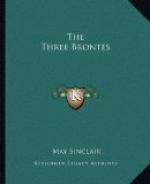But he was the kind of figure that is irresistible to the caustic or humorous biographer. There was something impotently fiery in him, as if the genius of Charlotte and Emily had flicked him in irony as it passed him by. He wound himself in yards and yards and yards of white cravat, and he wrote a revolutionary poem called “Vision of Hell”. It is easy to make fun of his poems, but they were no worse, or very little worse, than his son Branwell’s, so that he may be pardoned if he thought himself more important than his children. Many fathers of the Victorian era did.
And he was important as a temporary vehicle of the wandering creative impulse. It struggled and strove in him and passed from him, choked in yards and yards of white cravat, to struggle and strive again in Branwell and in Anne. As a rule the genius of the race is hostile to the creative impulse, and the creative impulse is lucky if it can pierce through to one member of a family. In the Brontes it emerges at five different levels, rising from abortive struggle to supreme achievement—from Mr. Bronte to his son Branwell, from Branwell to Anne, from Anne to Charlotte, and from Charlotte to Emily. And Maria, who died, was an infant prodigy.
And Mr. Bronte is important because he was the tool used by their destiny to keep Charlotte and Emily in Haworth.
The tragedy we are too apt to call their destiny began with their babyhood, when the mother and six children were brought to Haworth Parsonage and the prospect of the tombstones. They had not been there eighteen months before the mother sickened and died horribly of cancer.
She had to be isolated as far as possible. The Parsonage house was not large, and it was built with an extreme and straight simplicity; two front rooms, not large, right and left of the narrow stone-flagged passage, a bedroom above each, and between, squeezed into the small spare space above the passage, a third room, no bigger than a closet and without a fireplace. This third room is important in the story of the Brontes, for, when their mother’s illness declared itself, it was in this incredibly small and insufferably unwholesome den that the five little girls were packed, heaven knows how, and it was here that the seeds of tuberculosis were sown in their fragile bodies. After their mother’s death the little fatal room was known as the children’s study (you can see, in a dreadful vision, the six pale little faces, pressed together, looking out of the window on to the graves below). It was used again as a night-nursery, and later still as the sleeping-place shared by two, if not three, of the sisters, two of whom were tuberculous.




